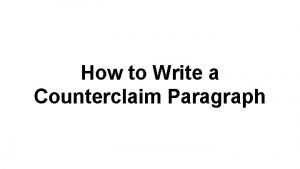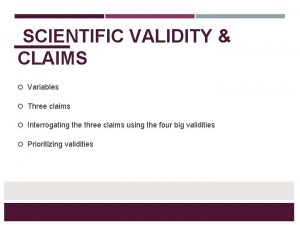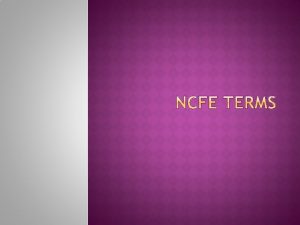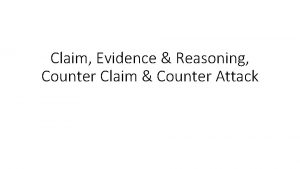Claim The overall thesis the writer will argue




- Slides: 4

Claim • The overall thesis the writer will argue for. • You are either in support of the Redskins maintaining their current name OR You are in support of the Redskins changing your name. • You can qualify your argument and be halfway between the sides. This is just a bit more complicated! • Address your claim in the intro. This is your thesis! • You will address two main points to support your claim in the next two body paragraphs.

Counterclaim • A claim that negates or disagrees with thesis/claim. • This is where you address the alternate viewpoint. • Address the STRONGEST argument • Provide some support from articles, videos, etc. • The general argument made by author X in her/his work, ________, is that ________. More specifically, X argues that ________. She/he writes, “ ________. ” In this passage, X is suggesting that ________. In conclusion, X’s belief is that ________. • Critics argue… • Others may say…

Rebuttal • Evidence that negates or disagrees with the counterclaim. • This is where you will take down the counterclaim • Again, add some support to this! Directly address the counter. Do not repeat a reason you have already given to rebut the counterclaim! The rebuttal should focus specifically on the objection in the counterclaim. If you merely repeat what you have already said, your audience will assume you cannot think of an effective response. • While author x believes …. , this is untrue, false, etc.

• Use Signal Verbs that fit the Action • Avoid bland formulas “he talks about", it can kill your passion, try to use "he challenges, chastises, and indicts" etc. • Authors emphasize and insist in their arguments, not simply discuss things. • II. “As He Himself Puts It” The Art of Quoting • To have an effective argument, learn how to include arguments of others into your paper. • Quoting someone else gives a lot of credibility. It proves someone else agrees in your argument. • You have to remember that a quote is not always obvious to readers and therefore must be explained • Quote Relevant Passages • Writing is an evolving process, you have to be careful on a quotation that seems perfect may no longer work. • No back and forth in your argument. • Frame Every Quotation • Quotations that don’t have a frame are dangling quotes. • To properly frame a quote, you need to insert it into what the “quotation sandwich” is. ( It’s in between “the lead in” and then “the follow up statement. ”) • Blend the Author’s Words with Your Own • Complex quotes with jargon, details, & hidden complexities would require more explanation that a simpler quote. • It’s better to over explain than to leave it dangling. • How Not to Introduce Quotes • Don’t introduce a quote that is redundant or misleading • To prevent this, ask yourself "How has the writer integrated the quote into their own text"?







